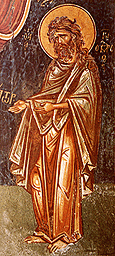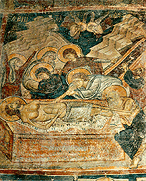 |
|
 |
Painting: 1330-1360
 he period from 1330 until about 1360, contrary to the previous one,
he period from 1330 until about 1360, contrary to the previous one,
 does not have many or important monuments to show. The paucity of works of art may be observed as much in the central regions of the Empire as in the more distant ones. In the view of M. Chatzidakis, the generality of the phenomenon is probably not unrelated to other factors, such as the critical political situation and the religious and social disputes going on at the time. The creative spirit and innovations in general are missing from the paintings of this period. does not have many or important monuments to show. The paucity of works of art may be observed as much in the central regions of the Empire as in the more distant ones. In the view of M. Chatzidakis, the generality of the phenomenon is probably not unrelated to other factors, such as the critical political situation and the religious and social disputes going on at the time. The creative spirit and innovations in general are missing from the paintings of this period.
 The artists are content to reproduce, with a certain awkwardness, the successful models of the first three decades of the century, while they focus their interest on the enrichment of the iconographic programmes, laying particular stress on the narrative aspect. In certain monuments, such as the monastery of the Hypapante at the Meteora (1366) and in the church of the Holy Taxiarchs Metropoleos in Kastoria (1359), classicism gives way to a more expressive, often anti-realistic mode. At the same time we find certain works in which new ways of expression make their appearance. The frescoes of the church of St Nicholas, at Platsa in the Mani (1337/8), for instance, are characterised by the combination of elements of the classical tradition with dynamic and realistic features. The powerful alternations of bright colours, free brushstrokes and tints that lend vivacity to the faces, are features that give to the paintings of Platsa a progressive character and connect them to the artistic developments of the next period. The view, therefore, that the painter of the monument must have come from Mistra, the artistic centre of the region, seems quite logical. The artists are content to reproduce, with a certain awkwardness, the successful models of the first three decades of the century, while they focus their interest on the enrichment of the iconographic programmes, laying particular stress on the narrative aspect. In certain monuments, such as the monastery of the Hypapante at the Meteora (1366) and in the church of the Holy Taxiarchs Metropoleos in Kastoria (1359), classicism gives way to a more expressive, often anti-realistic mode. At the same time we find certain works in which new ways of expression make their appearance. The frescoes of the church of St Nicholas, at Platsa in the Mani (1337/8), for instance, are characterised by the combination of elements of the classical tradition with dynamic and realistic features. The powerful alternations of bright colours, free brushstrokes and tints that lend vivacity to the faces, are features that give to the paintings of Platsa a progressive character and connect them to the artistic developments of the next period. The view, therefore, that the painter of the monument must have come from Mistra, the artistic centre of the region, seems quite logical.
See also: Kastoria, Taxiarches Metropoleos
|